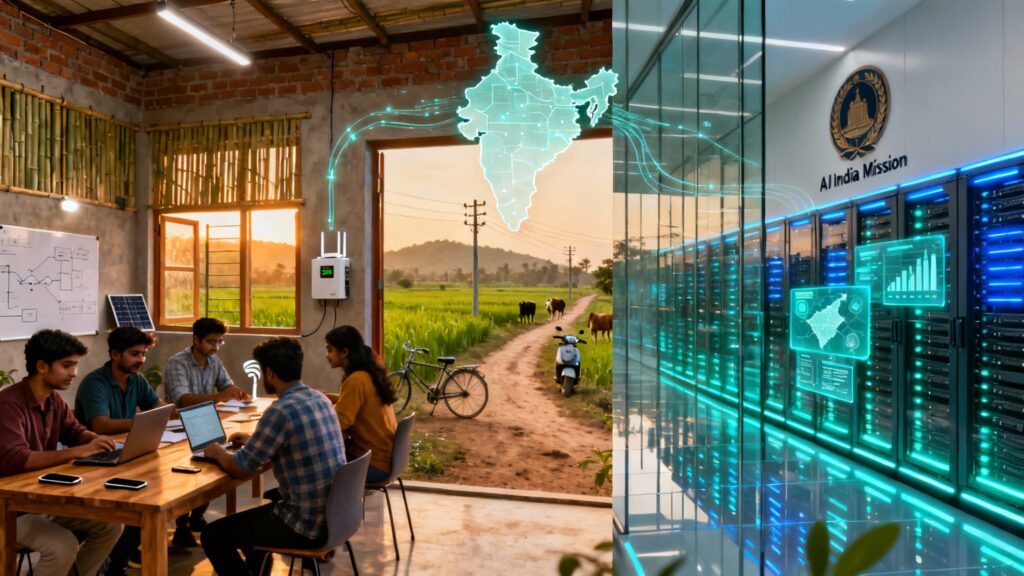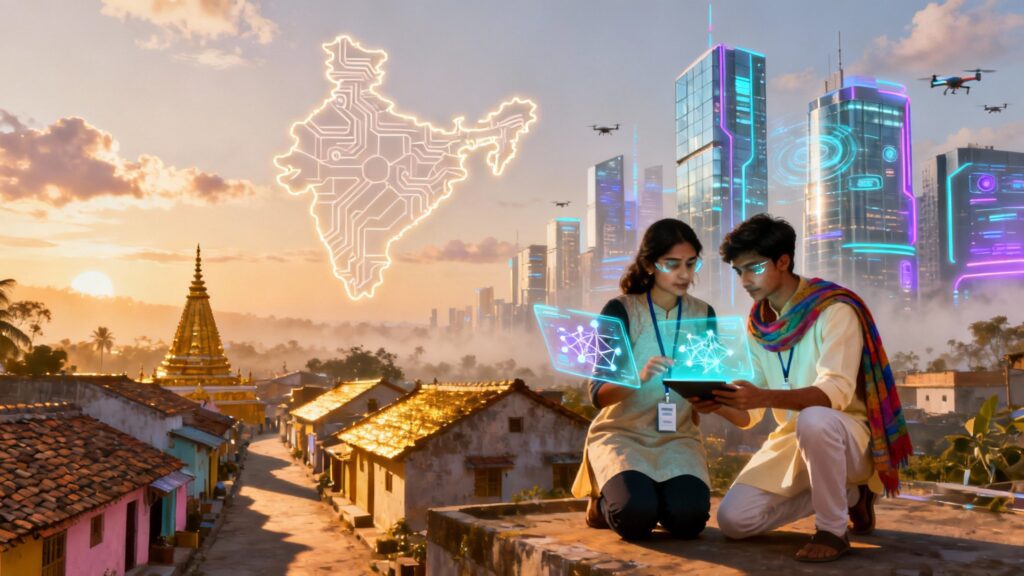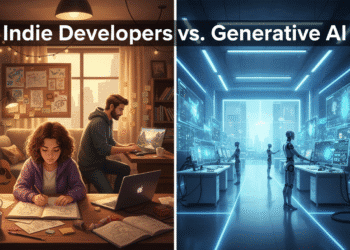How India is positioning itself as a global AI powerhouse through grassroots innovation and ambitious national initiatives

India is making bold moves in the artificial intelligence landscape, pursuing a dual strategy that combines grassroots AI training in rural towns with an ambitious plan to develop its own sovereign AI model. This multi-pronged approach reflects the country’s determination to become a major player in the global AI ecosystem while ensuring that the benefits of this technological revolution reach every corner of the nation.
AI Training Takes Root in Rural India
While Silicon Valley remains synonymous with cutting-edge technology, a quiet revolution is unfolding in India’s smaller towns and villages. Places like Virudhunagar, a town in southeastern India known for its ancient temples, are now home to a thriving AI industry that’s challenging traditional notions about where tech work happens.
Mohan Kumar, an AI annotation specialist working in Virudhunagar, represents this new wave of tech workers. “My role is in AI annotation. I collect data from various sources, label it, and train AI models so they can recognize and predict objects,” he explains. His work involves preparing the datasets that teach AI systems to understand and interpret the world around them.
This trend, known as “cloud farming,” has been gaining momentum for years. Companies have discovered that they can deliver the same quality of work from rural locations at significantly lower costs for both staff and infrastructure. The rise of AI has given this movement another substantial boost, with numerous towns across India now hosting firms dedicated to AI-related work.
Breaking Down Geographic Barriers
Kumar’s experience challenges the assumption that tech workers in smaller towns are at a disadvantage. “Professionally, there is no real difference. Whether in small towns or metros, we work with the same global clients from the US and Europe, and the training and skills required are the same,” he says.
Desicrew, Kumar’s employer, was a pioneer in this space when it was founded in 2005. “We realised that instead of forcing people to migrate to cities in search of jobs, we could bring jobs to where people already live,” says Mannivannan J K, the chief executive of Desicrew. “For too long, opportunities have been concentrated in cities, leaving rural youth behind. Our mission has always been to create world-class careers closer to home, while proving that quality work can be delivered from anywhere.”
The company handles various outsourced tasks, including software testing for startups, building datasets to train AI, and content moderation. Currently, 30 to 40% of Desicrew’s work is AI-related, but J K predicts this will grow to 75 to 100% very soon.
Much of this AI work involves transcription converting audio to text. “Machines understand text far better,” J K explains. “For AI to work naturally, machines must be trained to understand variations in how people speak. That’s why transcription is such a crucial step; it forms the foundation for machines to comprehend and respond across languages, dialects, and contexts.”
Empowering Women Through Technology
One of the most significant impacts of this rural AI boom has been the creation of opportunities for women. Around 70% of Desicrew’s workforce are women. “For many, this is their first salaried job, and the impact on their families is transformative – from financial security to education for their children,” says J K.
NextWealth, another early mover in cloud farming founded in 2008, reports similar demographics. With 5,000 staff across 11 offices in smaller towns, approximately 60% of their workforce are women. “Sixty percent of India’s graduates come from small towns, but most IT companies hire only from the metros. That leaves behind a huge untapped pool of smart, first-generation graduates,” says Mythily Ramesh, co-founder and managing director of NextWealth.
“Many of these students are first-generation graduates. Their parents are farmers, weavers, tailors, policemen – families who take loans to fund their education,” she adds. NextWealth started with outsourced back-office work but pivoted to AI five years ago. “The world’s most advanced algorithms are being trained and validated in India’s small towns,” Ramesh notes.
Around 70% of NextWealth’s work comes from the United States. “Every AI model, from a ChatGPT-like system to facial recognition, needs vast amounts of human-labelled data. That is the backbone of cloud-farming jobs,” Ramesh explains.
The Future of AI Work in India
Ramesh is optimistic about India’s prospects in this sector. “In the next 3–5 years, AI and GenAI will create close to 100 million jobs in training, validation, and real-time handling. India’s small towns can be the backbone of this workforce,” she predicts.
However, she acknowledges competition is emerging. “Countries like the Philippines may catch up, but India’s scale and early start in AI sourcing gives us a five to seven-year advantage. We must leverage it before the gap narrows.”
KS Viswanathan, a technology advisor who formerly worked at India’s National Association of Software and Service Companies, believes India is at a critical juncture. “Silicon Valley may be building the AI engines, but the day-to-day work that keeps those engines reliable increasingly comes from India’s cloud farming industry,” he says. “We are truly at a tipping point. If cloud farming continues to scale, small-town India could well become the world’s largest hub for AI operations, just as it became the hub for IT services two decades ago.”
India’s Sovereign AI Ambitions
While rural India trains AI models for global clients, the Indian government is pursuing an even more ambitious goal: developing its own sovereign Large Language Model (LLM). This initiative represents India’s determination to have indigenous AI capabilities that aren’t dependent on foreign technology.
The IndiaAI Mission Takes Shape
According to Electronics and IT Secretary S. Krishnan, India’s sovereign AI model will be ready before the AI Impact Summit scheduled for February 2026. Speaking at the India Mobile Congress 2025, Krishnan revealed that India has rapidly scaled up its compute infrastructure, deploying 38,000 graphics processing units (GPUs) against an initial target of 10,000.
“Before the end of this year, hopefully, we should have our first foundational model entirely an Indian foundational model. By the time of the India AI Summit, we should be able to launch India’s sovereign model as well,” Krishnan announced.
The government is supporting 12 domestic firms in this endeavor, with two expected to have their foundational models ready by the end of 2025. In September, the government selected eight organizations to develop foundational large language models under the IndiaAI Mission, including Tech Mahindra, Fractal Analytics, BharatGen (IIT-Bombay Consortium), Avataar AI, Shodh AI, Zeinteiq Aitech Innovations, Genloop Intelligence, and NeuroDX (Intellihealth).
For IIT-Bombay’s proposed LLM alone, the IndiaAI Mission is allocating financial assistance of ₹988.6 crore. The total outlay for the IndiaAI Mission stands at ₹10,300 crore.
ICAI’s Critical Role in Data Support
A crucial component of India’s sovereign AI initiative is the participation of the Institute of Chartered Accountants of India (ICAI). The institute has announced plans to collaborate with the Ministry of Electronics and Information Technology (MeitY) to provide authenticated financial and economic data to developers working on India’s sovereign LLM.
“We are in discussions with MeitY. ICAI has a proposal to provide financial and economic data to the India-grown LLMs,” an ICAI official told ETCFO. “We can give authenticated financial data for the LLMs.”
The institute confirmed it is in contact with 10 companies developing India’s own Large Language Models. ICAI’s contribution will focus on providing credible and structured datasets, such as balance sheets and audit reports of listed firms, to strengthen the accuracy and reliability of India’s sovereign AI system.
Importantly, ICAI clarified that this data sharing would not violate the Digital Personal Data Protection (DPDP) Act, as only publicly disclosed data of listed entities will be shared. With over 400,000 members, ICAI plays a central role in accounting, auditing, and financial reporting standards in India, making its participation particularly valuable.
According to Business Today, ICAI is in talks with the shortlisted firms to discuss how they can provide data on 5,000 listed companies. “We want to tie up with them to provide them the financial data of the 5,000 listed firms so that they can be accessed through AI,” said an ICAI official. The objective is to help Chartered Accountants and sectoral specialists access economic and financial data easily and in an accessible manner.
Training the Next Generation of AI-Ready Professionals
ICAI is also taking steps to ensure that India’s accounting professionals are prepared for an AI-driven future. The institute announced that all students passing the Chartered Accountancy final examination from 2027 onwards will be “AI competent.” It is considering including AI as part of the syllabus in future revisions.
“Even now, students are learning the mother language of AI,” ICAI noted during a presentation on ‘Future of Audit – Leveraging AI to Empower Future Auditors’ at a media event in Goa.
The institute has created AI-powered utilities and GPT tools to support the professional work of auditing. Chartered Accountants are already using AI tools to improve auditing processes and cut down on repetitive tasks. “AI is being used for complex transactions and to go through big data for speed and transparency in audit work,” an official noted, while underlining that assurance-related tasks cannot be given to AI and must be handled by CAs.
AI enables automating repetitive tasks, continuous data auditing, and the use of data analytics for fraud detection and risk assessment. Each year, about 25,000–30,000 new chartered accountants enter the profession, and ICAI’s initiative will ensure they are equipped with AI skills from the start.
Curriculum Reforms and Global Expansion
ICAI has outlined several reforms in its curriculum and examination structure. The foundation level will continue to have four papers, while the intermediate and final levels will now have six papers each, down from eight earlier. Four subjects have been moved to Self-Paced Online Modules. The articleship period has been reduced to two years from three, followed by a six-month preparation window before the final examination.
The institute is also developing an international curriculum to enable Indian students to understand global compliance and regulatory frameworks. Mauritius and Ethiopia have been selected for the initial phase of syllabus mapping, with more countries to follow.
Additionally, ICAI is collaborating with law enforcement agencies to detect and prevent financial frauds, estimated at around ₹28,000–30,000 crore annually. It is training chartered accountants using AI-enabled tools to identify and prevent such activities, with expectations that these measures could reduce fraud by nearly 25%.
Challenges and Opportunities Ahead
While India’s AI ambitions are impressive, several challenges remain. Infrastructure concerns persist in some rural areas. While companies like NextWealth and Desicrew report access to reliable and secure internet connections, Viswanathan cautions that this isn’t always the case across India’s smaller towns.
“Reliable high-speed internet and secure data centres are not always at par with metros, which makes data protection a constant concern,” he notes. Even when good connections are in place, work needs to be done to reassure international clients. “The bigger challenge is the perception rather than a technical one. International clients often assume small towns cannot meet data security standards, even when the systems are robust. Trust has to be earned through delivery.”
For the sovereign AI initiative, the challenge lies in competing with well-funded global players. The emergence of models like DeepSeek, which achieved impressive results at relatively low training costs, has shown that innovation can come from unexpected places. However, developing and maintaining competitive AI models still requires substantial ongoing investment.
Abhishek Singh, Additional Secretary at MeitY, emphasized that India’s sovereign AI model will be completely trained on Indian datasets and hosted on Indian servers. This approach ensures data sovereignty and reduces dependence on foreign infrastructure, but it also requires sustained investment in compute capacity and talent development.
A Transformative Impact
The real-world impact of India’s AI initiatives is already visible. Dhanalakshmi Vijay, who works at NextWealth “fine-tuning” AI models, describes how her work improves everyday experiences. If an AI system confuses two similar-looking items, like a blue denim jacket and a navy shirt, she corrects the model.
“These corrections are then fed back into the system, fine-tuning the model so that the next time it sees a similar case, it performs better. Over time, the AI model builds up experience, just like updating software with regular patches to make it more accurate and reliable,” Vijay explains.
Such work has tangible effects. “It’s me and my team who indirectly train the AI models to make your online shopping experience easy and hassle-free,” she says.
Conclusion

India’s approach to AI development represents a unique blend of grassroots empowerment and national ambition. By bringing AI training work to rural areas, companies are creating opportunities for first-generation graduates and women who might otherwise have been left behind in the digital economy. Simultaneously, the government’s push for a sovereign AI model demonstrates India’s determination to be a creator, not just a consumer, of AI technology.
The collaboration between institutions like ICAI and the government’s IndiaAI Mission shows how India is leveraging its existing strengths a large pool of educated professionals, expertise in data management, and a tradition of innovation under constraints to carve out a distinctive position in the global AI landscape.
As Krishnan noted, the government is focusing not only on a national-scale model but also on smaller, sector-specific models aimed at boosting productivity in key areas such as agriculture, healthcare, and education. This pragmatic approach recognizes that AI’s true value lies in solving real problems for real people.
Whether training algorithms in ancient temple towns or developing sovereign AI models in government labs, India is writing its own chapter in the AI revolution one that prioritizes inclusion, sovereignty, and practical impact. The next few years will determine whether this ambitious vision can be fully realized, but the foundation is already being laid in the most unexpected places.
Sources
- BBC News – Why AI is being trained in rural India
- Economic Times CFO – ICAI collaborates with MeitY for India’s sovereign AI mission
- Business Today – ICAI looks to work with India’s sovereign AI model on financial, economic data
- The Hindu Business Line – ICAI to provide data support for India’s indigenous AI model









